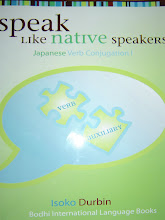こうしん しないと
koushin shinaito
I translated literally this time. (Usually, I don't.) This sentence is not completed, but in Japanese you can hear this kind of language A LOT! Usually this kind of expressions include more than literal meaning. This one, 更新しないと, think about this. If "I don't update this blog," what will happen? "NOBODY WILL READ IT!" It was my sigh. And I was encouraging myself "you've better update your blog, otherwise nobody will read it!"
にほんブログ村


Hello, I have some questions, but not connected to this post...
ReplyDeleteHow do you know which kanji should be used? I mean - very often they sounds similar/the same, is it about their meaning? (e.g. someone is talking in japanese and you want to write what he/she sais - how do you know which kanji you should write?)
Is it a mistake when you write hiragana instead of kanji?
And if you read some text, how do you know how you should read aloud the kanji?
I suppose you have to learn it at school, right? Kanji with all meanings and all readings?
I would be very glad if you can answer me :)
Cheers!
That is a good question! But unfortunately, I do not have a great answer. I think you have to learn all Kanji. Each Kanji letter has meanings and pronunciations. (and they are more than one!) I know that is so confusing. But good thing is that most Japanese people do not know all Kanji, either! Certainly, I don't. So what should you do if you don't know the Kanji? Just use Hiragana. It is perfectly okay to use Hiragana to substitute Kanji, and that is what we do.
ReplyDeleteOne good thing to write on computer is that they will tell you "options" of Kanji. For example, the Kanji in today's phrase, 更新, it is spelled "koushin." If you have Japanese language system, type "koushin." You will get:
更新、後進、行進、交信、後身,and more. Because I know "update" is 更新, I just click it. Sometimes I don't know the Kanji, but choose from options. I think writing on computer is a great way to learn Kanji.
Please do not get discouraged to learn Kanji. There are some tendencies. For example, the left part of both 泳 and 河 means "water." Can you see "splash of water" there? So 泳 means "to swim" and 河 means "river." You see the tendency? Both kanji letters are related to water. I hope you enjoy the connection of Kanji and learning the very interesting world!